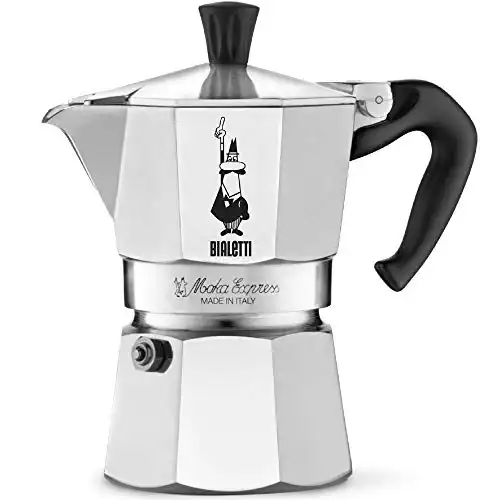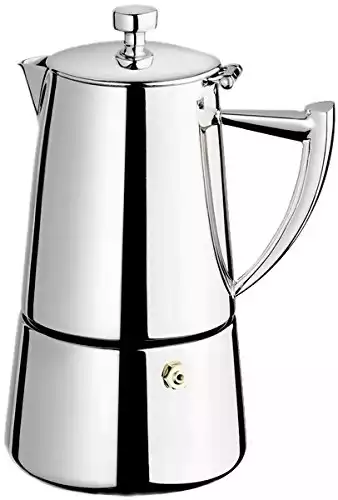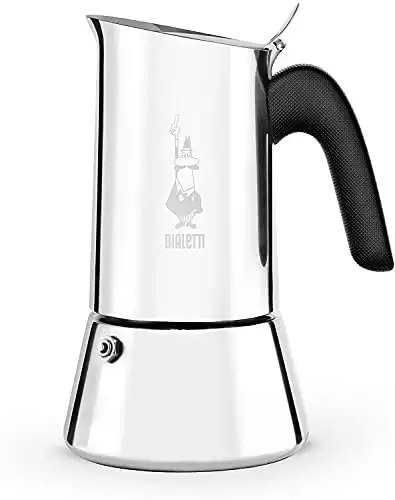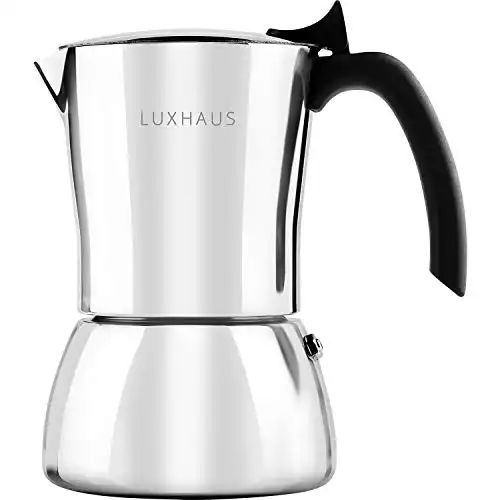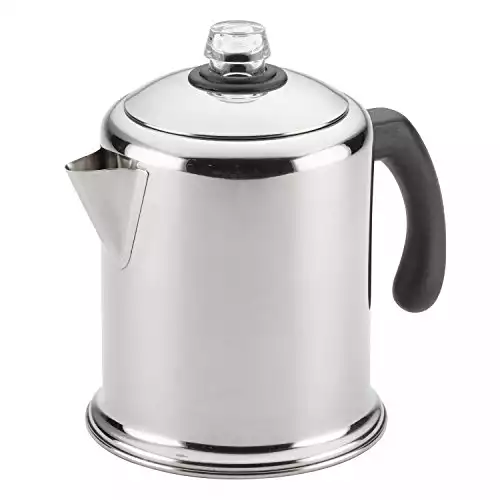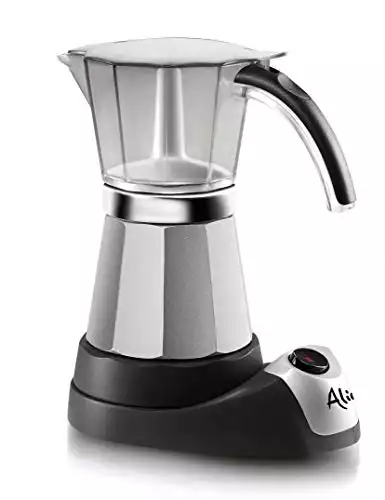The 6 Best Moka Pot Picks Of 2024 (Stovetop Espresso)
There might be 100 ways to brew a cup of joe, but which one is your favorite?
Some of the best ways to make something are often the simplest. Coffee is no exception, especially when it comes to the Moka pot, aka stovetop percolator.
Regardless if you’re new to this kind of brewing or if you’re just looking for a replacement coffee percolator, in this guide we are going to find the best moka pot for you!
But, If you’re in a hurry and just want to check out the best moka pot in our opinion, you can find it below:
Best Alternative Moka Pots in 2024
The 6 Best Moka Pots 2024 (Stovetop Espresso)
Below we run through the best stovetop esspresso makers, outlining the pros and cons of each pick.
Let’s get started with our favourite:
1. Bialetti Moka Express Stovetop Espresso Maker
Bialetti is the old school king of stovetop coffee makers. Having manufactured over 200 million coffee makers since the 1950s, they certainly know what they are doing!
PROS (+)
- Premium craftsmanship
- A variety of cup size
- Designed in Italy
CONS (-)
- Not suitable for Induction stovetops
- Not dishwasher safe
Designed in Italy like most of the best moka pots, the Bialetti express has a unique octagon design and is lightweight due to being manufactured from aluminium.
With perfect heat distribution and super easy disassembly, the Bialetti comes in 1, 3, 6, and 9 cup sizes to please even the largest family.
When it comes to Moka pots, the moka express is in a league of its own. Brewing a perfect cup of coffee quickly and efficiently every time.
Nonetheless, while the Bialetti moka pot raises the brewing bar, it’s not perfect by any means. Being carved from aluminum means its subject to oxidation and isn’t suitable for induction worktops.
Still, this is our personal favorite by far and I use it at least a few times a week. It genuinely makes the best stovetop espresso, which only gets better each time you use it.
Note, that while it’s easy to clean, you need to remember not to use soap but just rinse it off with water!
Related Read: Italian Coffee Maker Brands
2. Cuisinox Roma Stovetop Moka Espresso Maker
If you’re looking for a premium design and don’t mind paying for it the Cuisinox is for you. Excluding the gaskets, its made entirely from steel, meaning it’s built to last.
PROS (+)
- Elegant design
- Suitable for all stovetops
- Adjustable brew capacity
- Easy to clean
CONS (-)
- The handle isn’t heat resistant
- Expensive
With its variety of size options, you can pick from a 1-10 cups (up to 15 ounces capacity) to meet your brewing needs, and the larger cup sizes have inbuilt adjustable brewing capacity for times when you don’t need as much.
As a result, it’s durable, dishwasher safe, and looks great on any worktop. Its induction base also means you can brew great coffee on any stovetop without an issue!
Interestingly, the Roma espresso coffee maker comes with a 25-year warranty. Yup, that’s right…25 years! As a result, when you add this into the mix, it certainly becomes more attractive.
Given its premium price point, the handle isn’t plastic or wood-like other moka pot; its pure stainless steel. Although, this can wreak havoc with your hand if you don’t use gloves or a cloth to avoid burning yourself each time you pour.
3. Bialetti Venus Induction Espresso Coffee Maker 6 Cup
The venus is a newer model from Bialetti to cater for induction stovetops. Its made from premium stainless steel to ensure longevity and its elegant design mean it doesn’t go unnoticed on any worktop.
PROS (+)
- Beautiful design
- Robust stainless steel construction
CONS (-)
- Premium price point
- Loud
If you’ve got an induction cooker and want an Italian designed stovepot espresso maker to rival the original Bialetti moka express, then look no further.
With its insulated handle, the venus also gives you peace of mind that you won’t get burnt while pouring the perfect cup of coffee.
However, there is a learning curve associated with this moka pot, and it can take some time to yield the best stovetop espresso from it. So, if you’re willing to be patient and experiment then great!
4. luxHaus Stovetop Espresso Coffee Maker – 6 Cup Moka Pot
PROS (+)
- Food grade stainless steel carafe
- Premium look without the price point
- Works on any stovetop
CONS (-)
- Thin sprout can lead to overflow
- Need to pour slowly to avoid steam exiting
Glass, electric, or induction the LuxHaus moka pot will brew you a tasty 6 cups of coffee.
The carafe is made from stainless steel and has a 10 ounce capacity, avoiding any problems with oxidation.
Additionally, the team at LuxHaus is so confident you will love it that they also offer a lifetime satisfaction guarantee!
5. Farberware Stainless Steel Yosemite Moka Pot
Love the outdoors but want to drink fresh coffee without oxidation? The Farberware coffee percolator is built with on the go use in mind.
PROS (+)
- Heavy-duty stainless steel
- Perfect for outdoor family trips
- 12 cups capacity
CONS (-)
- Glass percolator is fragile
Manufactured to last it uses a heavy-duty stainless steel construction, with a glass percolator knob you can quickly see when your coffee is ready to drink.
Like the LuxHaus the Farberware also comes with a limited lifetime warranty, so you can buy with confidence it will last.
It has a capacity of 12 cups (64 ounce!) makes it an excellent buy for any family who loves coffee and wants excellent coffee.
6. De Longhi EMK6 Electric Moka Pot, 6 Cups
Need a Moka Pot which will work anywhere as long as its plugged in? The De Longhi does just that!
PROS (+)
- Super easy to use
- Modern design
- All in one unit
CONS (-)
- Little brew control
- Taste isn’t as good as a traditional moka pot
If you want to make sure you can enjoy Moka Pot coffee without a stovetop espresso maker, this picks for you. Compact enough to be used in a small kitchen or on the go in an RV. As an all in one unit, you just need a power source and it’ll quickly brew you a quality coffee.
While it makes a strong coffee, there is little brewing control because it’s plugged in and controlled by a switch.
If you value convenience over all else, this is the right one for you.
The Final Verdict
For us, there’s one clear winner. The Italian made Moka Express by Bialetti! When it comes to stovetop coffee makers, there isn’t really a better option in our opinion. Plus, we love its classic design!
It’s the original Italian stovetop espresso maker, which delivers a consistent brew at a friendly price point.
While stainless steel Moka pots are favourites for those of us looking for an easily cleaned Moka pot and a premium finish, I love the traditional nature of a Bialetti.
Best Moka Pots Buying Guide
Invented by an Italian engineer called Alfonso Bialetti way back in 1933, stovetop esspresso is now a regular part of Italian coffee culture, and Italian made coffee makers like these have permeated across the globe.
The versatility of a moka pot to brew without the need to harness electricity along with the ability to make multiple cups in one shot makes it a godsend. Especially if you’re on the go or just enjoy the traditional coffee-making methods.
While the traditional moka pot is a stovetop espresso maker and only requires a naked flame for heat, modern electric moka pot options are now also available.
If you want full brewing control, you’ll probably want a stovetop coffee maker. But if you just want it to do to the job without any responsibility and avoiding an over-brewed pot, go for an electric moka pot.
It’s important to note that technique and the type of coffee you use along with the grind size of your coffee grounds can make a huge difference to the brew – but we’ll get into that later.
Related Read: How To Use A Moka Pot
So how do you judge the many different moka pots on the market today?
Origin: Italian Moka Pots Or Not?
When it comes to the best Moka Pots, I don’t favor one country over another. However, these things originate from Italy, and some people suggest the best moka pots are made or designed there – which makes sense.
The Bialetti is still designed in Italy, but it’s no longer produced there since its production shifted production to China in 2010.
You will notice stovetop espresso makers designed or produced in Italy might come with a slight price premium. It’s something to consider if you’re looking for an authentic and the best Moka Pot, which will last the test of time. You can see my Bialetti working hard after years of use below:
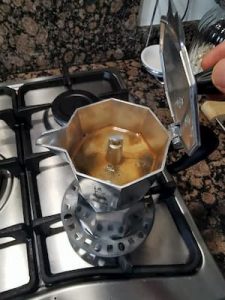
Capacity: How Many Cups Can It Brew?
The size of a cup from Moka Pots can differ!
While we might assume that the cup size used in the states is what’s standard around the world, it often isn’t the case.
So, if you’ve assumed cup capacity is uniform across brands, don’t! Unfortunately, there isn’t a universal size for a cup, and it can vary.
You will often find products designed in Europe will have a smaller volume measurement per cup (e.g Bialetti). It’s important to remember in Europe a cup is traditionally smaller than in the states.
Instead, look at the measurement in ounces. From there, it’s easy to figure out the amount of coffee you will be able to pour from the espresso maker.
This way, you can easily discount some options due to their volume constraints. Remember, the best moka pot for us might not be the same for you if it doesn’t meet your capacity needs!
Will It Work With My Stove top?
Not all moka pots work with an electric or induction stove, but all work with gas.
If you don’t have a gas stovetop, be sure to check if the one you want to buy is compatible. Thankfully, there are many options regardless of whether you’ve got an electric stove or just want something that works on both gas and electric.
Just remember that induction stoves require a magnet at the bottom of the moka pot to function! You can’t use a brewer designed for use on a gas stove for coffee making on your induction cooker.
Warranty
Warranty can give you peace of mind that if the item breaks down in use, it’s easily replaced without an added cost.
You will find that with Moka Pots it can vary from one year right through to a lifetime! Be sure to look beyond the price point as otherwise, if you’re out of warranty and your espresso maker breaks, it’s going to cost you money to get a new moka pot.
Cleaning
As moka pots have three chambers and gaskets to maintain pressure, each piece needs to be individually cleaned for the best performance.
I’ll admit, cleaning them can be a pain if you’ve not got the right technique, especially if you have an aluminum moka pot, which requires extra care to maintain the seal. Nonetheless, you just need to use warm water to rinse the moka pot if its alumninum (don’t use soapy water no matter what you do!).
As a result, stainless steel ones are considered the easiest to clean. Often, they can be partially disassembled and placed directly into a dishwasher.
But, do if you’re seeking a traditional Italian experience, you might not want a stainless steel stovetop espresso maker.
Aluminum Moka Pots Vs Stainless Steel
Traditionally, a moka pot is made from aluminum.
While this conducts heat evenly, making a strong coffee can lead to higher oxidation levels (build up on the pot). While this is considered safe, for some, the grungy look and taste disruption is too much.
On the other hand, a stainless steel stovetop coffee maker doesn’t conduct heat nearly as well and can lead to uneven heat distribution regardless of the age of the espresso maker.
Want something easy to clean? A Stainless steel moka pot is often dishwasher safe, which can be useful, especially if you’re brewing regularly!
Nonetheless, if you’re after a rapid brew stovetop coffee, then you’re better off with aluminum as in my experience, it brews better and faster.
If you do decide to go traditional, a trick is not to wash the aluminum moka pot. Instead, rinse it under hot water and use a non corrosive cloth to ensure the coffee’s oils remain on the surface of the pot.
This is one of the reasons traditional Bialetti moka pots can look filthy after a while. Keeping them this way keeps them sealed and avoids flavor disruption.
But hey, doesn’t the tired look add to its character? If you think, so you’ll need to avoid stainless steel construction for that aged look.
Frequently Asked Questions
How Does A Moka Pot Work?
With its triple pressurized chamber, a moka pot uses a steam vacuum power coupled with a coffee filter.
Water is heated in the bottom chamber by exposing it to a heat source (e.g gas or electric stoves), as the water boils, steam rises to the top via a tube with a perforated top edge. Resulting in a vacuum that saturates the coffee grounds, which pushes the brew up into the final chamber. The sprout in the upper chamber makes a hissing sound when the coffee is ready.
Coffee makers under pressure like Moka Pots have a release valve attached, so they’re safe to use without worrying.
Is Moka Coffee As Strong As Espresso
Coffee from a moka pot isn’t as strong as a traditional espresso machine, but it is stronger than drip coffee.
As a result, the coffee isn’t the same as an espresso shot from a professional coffee maker but, it’s super portable and economical!
Crucially, without the need to harness electricity, a Moka pot can be used both at home and while outdoors for espresso like quality coffee.
Which Is Better French Press Or Moka Pot?
This is more of a preference than a definitive answer. For some of us, its a moka pot all the way for a high quality full-bodied brew.
Although there are is some specific criteria to consider:
French press coffee is steeped, whereas a moka pot is (lightly) pressurized. French press coffee is full-bodied vs a more potent and sharper brew from a stovetop espresso maker.
Which do you prefer?
Moka pots also require a little more trial and error to get right. However, once you have mastered the art, you can make some of the most high quality coffee you’ll taste without a machine!
Is Moka Coffee Bitter?
If you over-extract, yes, it can turn bitter.
This is often a result of adding too little water or using too fine grounds, which can end up with over-extraction when it comes to brewing your cup of joe.
Lesson: use the right amount of (pre-heated mineral ideally) water and a medium-fine ground coffee for stovetop espresso!

